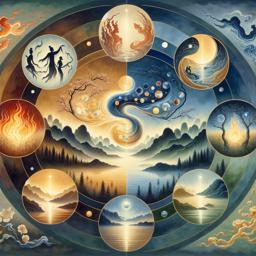
Overview of TCM and Meridian Theory
Introduction to the Principles of TCM
Traditional Chinese Medicine (TCM) is a holistic approach to health and wellness that has evolved over thousands of years. It encompasses various practices, including acupuncture, herbal medicine, cupping, tuina (a form of therapeutic massage), and qigong (a type of breathing exercise). The central idea in TCM is to maintain or restore harmony within the body and between the body and the environment.
Core Principles of TCM
- Yin and Yang: Everything in the universe can be described as being part of two opposing but complementary forces. Yin represents qualities such as cold, rest, and darkness, whereas Yang embodies warmth, activity, and light. Health is achieved through the balance of these forces.
- Qi (Chi): Often translated as "vital energy" or "life force," Qi is fundamental in TCM. It is believed to flow through the body and is essential for maintaining health. Disruptions or imbalances in the flow of Qi can lead to illness.
- Five Elements: Wood, Fire, Earth, Metal, and Water are the five elements, and they represent different qualities of energy. They are used to understand bodily functions and the interrelation between different organ systems.
- Holistic Approach: TCM treats the body as a whole and takes into consideration the physical, emotional, and spiritual aspects of an individual. Diagnosis and treatment are personalized, focusing on restoring balance and harmony.
Historical Development of Meridian Theory
Meridian theory is a cornerstone of TCM, providing a framework for understanding how Qi moves through the body. The concept of meridians involves pathways or channels that transport Qi, blood, and other vital substances.
Origins and Evolution
- Ancient Texts: The roots of meridian theory trace back over 2,000 years to ancient texts such as the "Huangdi Neijing" (The Yellow Emperor's Inner Canon). This seminal work laid the foundations for understanding the meridian system and the practice of acupuncture.
- Twelve Primary Meridians: According to the theory, there are twelve primary meridians, each corresponding to specific organs and functions. These act as highways in the body, ensuring the smooth flow of Qi and contributing to overall health.
- Eight Extraordinary Meridians: Beyond the primary meridians, there are eight extraordinary meridians that are thought to provide additional support and store Qi for the body. They play a critical role in maintaining the body's energy balance and are often used in advanced TCM practices.
Development and Integration
- Acupuncture and Meridians: The use of acupuncture to manipulate the flow of Qi along the meridians is a key therapeutic technique in TCM. By inserting needles at specific points along these channels, practitioners aim to restore balance and alleviate health issues.
- Modern Research: Over the years, meridian theory has been explored through various research methodologies, merging modern biomedical perspectives with traditional understandings. The mapping of acupuncture points and meridians continues to be refined, contributing to a deeper awareness of their physiological effects.
Meridian theory remains a vital part of how TCM is practiced today. It provides a unique perspective on health and disease, one that complements and enhances other therapeutic modalities within holistic healthcare.
- tcm
- meridian theory
- qi
- acupuncture
- yin and yang